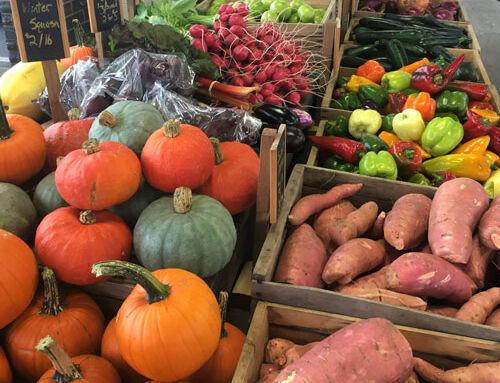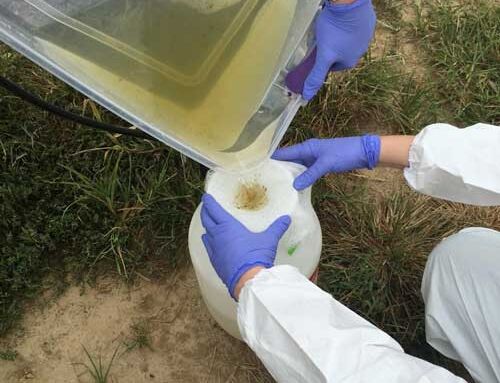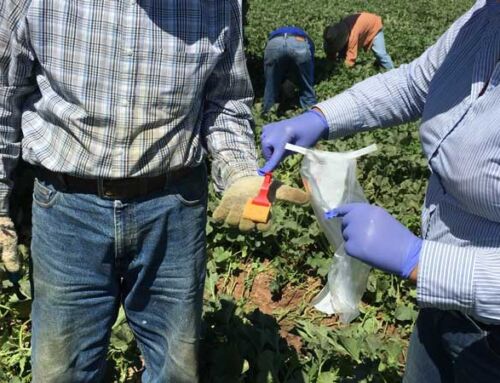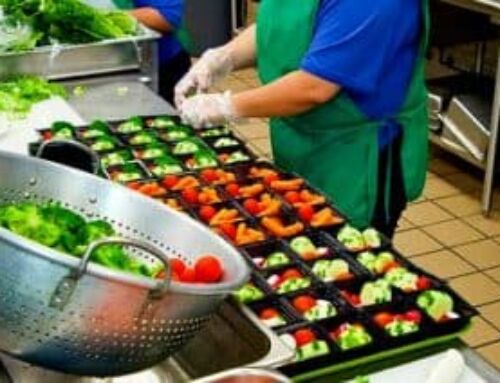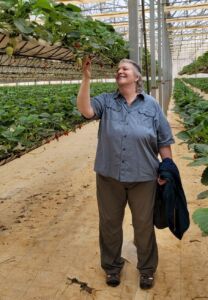 Amber Vallotton is an Extension Specialist, acting as the Fresh Produce Safety Coordinator for Virginia Cooperative Extension (VCE). She has been with Extension for close to 18 years, starting first as an agent in Rockingham County, VA, then her current role at Virginia Tech in 2014. She is the founder of the newly relaunched (2024) Virginia Fresh Produce Safety website. As a big welcome to the new blog, I spoke with Amber about her inspiration for the website and her impact in agriculture. Amber filled the conversation with years of insight and we hope you will find her work both inspiring and helpful in Virginia agriculture.
Amber Vallotton is an Extension Specialist, acting as the Fresh Produce Safety Coordinator for Virginia Cooperative Extension (VCE). She has been with Extension for close to 18 years, starting first as an agent in Rockingham County, VA, then her current role at Virginia Tech in 2014. She is the founder of the newly relaunched (2024) Virginia Fresh Produce Safety website. As a big welcome to the new blog, I spoke with Amber about her inspiration for the website and her impact in agriculture. Amber filled the conversation with years of insight and we hope you will find her work both inspiring and helpful in Virginia agriculture.
Q: What inspired you to create this website? In a nutshell, “..a need for tangible resources…”
When Amber first started this position, she saw a lack of tangible resources, specifically for the GAP certification process.
What is GAP certification?
- GAP = Good Agricultural Practices
- “It’s a way that farmers can verify that they have identified their risk and then put practices into place.”
- A third party audit.
“A clearinghouse of vetted resources…”
“It’s a one-stop shop—a place to start like a landing station to find content that’s been vetted for you, along with an annotated description of what that resource is.” She recognized that “there was a need for both people who were going to be training growers and the growers themselves. There was a real need to have some sort of a clearinghouse of resources. So, the website was always intended to provide [information to] both people who would train and the growers themselves. We also have a consumer part of the website, but our main focus is on produce growers. I think just having one thing in one place is what we really were after and so part of our goal is not only do we have a clearinghouse of resources, but all those resources on the website have been vetted — as to be the best resources that we feel are available. We’ve taken the time to sort through content, describe it, and make sure that it is what is most helpful for people.”
Q: Are there other collaborators for the website? “Yes.”
The website was funded by a grant in 2014 and the first edition was launched in 2018. This version is the 2024 relaunch, to release in August.
“…we have had input from several people…”
- Sarah Gugercin, Web Designer. “Sarah has been instrumental in developing the website platform as well as with this relaunch. She’s done many of the graphics behind the site.”
- Laura Strawn, Associate Professor. “Who is in Food Science Technology, VT. [She] has contributed to the Food Safety Modernization Act or FSMA section that’s on the site and some of the project highlights.”
- Alexis Hamilton, Assistant Professor and Extension Specialist; Melissa Wright, Director, Food Producer Technical Assistance Network; Lester Schonberger, Associate Extension Specialist; Renee Boyer, Professor and Department Head, Melissa Chase (a main contributor, retired) all in the Food Science and Technology Department. “They contributed to the Producer and Consumer site and it’s been that group of folks who have really been instrumental in helping me.”
Q: What is one of your favorite experiences working with the farmers? “it’s kind of hard to pick a favorite, you know, I love what I do.”
Amber has been involved in over 80 GAP audits.
“I think probably the one of my most favorite experiences was the first time I worked with GAP certification…What was really amazing about that time was learning the process myself, and so it was just a really wonderful time of getting to know the farmers better.”
Amber worked with Old Order Mennonite community farmers in the Shenandoah Valley where seven farms became GAP certified.
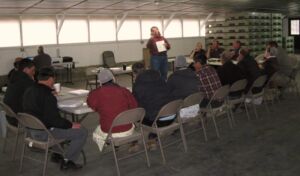
There were 12 who originally wanted to become certified, and some dropped out for various reasons, but she learned it was easier when farmers worked together to get certified. What was interesting to Amber about this particular community of farmers is how the families came together in the preparation process, and each member of a household would take on a role whether it be leading the implementation of farming practices, the record keeping, the manual preparation, etc.
“It was a really great partnership we had, I was able to assist them through the entire process.
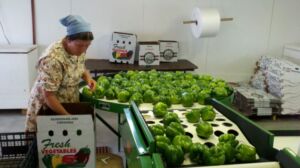
- Help them with getting their maps online
- Copying and getting their manual together with them step by step
- Attending the actual audits
“Just being there to see them become successful. That’s a fantastic thing to me. It was really amazing because they all passed with flying colors and that really launched me into this whole area of on-farm food safety and kind of became my signature area of work and then that led into me being transferred to Virginia Tech on campus in Blacksburg.”
Q: What is your most proud success story? “I’ve worked with so many growers, but then more recently, I was able to conduct an agent training.”
Amber describes a full circle GAP Certification agent training that took a community of extension professionals to create.

The agent training included:
- Training agents on how to mentor growers in GAP certification
- Identifying risks and practices for farmers to implement
- A preview of the website
- Lots of hands-on activities
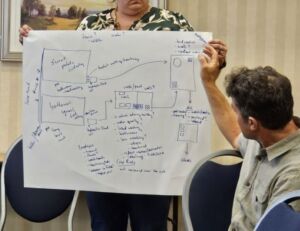
It required a village of extension and industry: “Not just one person does it, you know, we’re like a village or a community and so being able to share that knowledge and help others know how to do it successfully based on the years of experience we have. So that was really wonderful for me.”
- Extension collaborators included:
- Ashley Edwards and Joanne Jones
- Alexis Hamilton and Laura Strawn shared about FSMA
- Real world visits of
- Farms
- Packing facilities
Q: So what would you like to share about what you do? “The foundation of all the work that I do with food safety is really on this idea of approaching food safety from a risk-based approach… what we might call a food safety culture.”
“As a extension specialist. I’m kind of tasked primarily with focus on fresh produce food safety, how we can help growers identify their risks and come up with practices that will help mitigate those risks. I think as I’ve grown in my career, one thing I’ve seen is that the kind of the foundation of all the work that I do with food safety is really on this idea of approaching food safety from a risk-based approach, or understanding hazards, and then how to deal with those hazards — even more so what we might call a food safety culture.”
What is food safety culture?
“We’re not just interested in GAP certification per say, I mean, that’s important if that makes sense for a grower to get GAP certification –that’s a voluntary program. But really the food safety culture idea is one that says no matter what market you’re selling to, no matter how many sales you have or how much produce you might have. What’s important is to understand that risks are, can be a part of everything we do, right? So being able to identify risks and putting practices in place is critical.”
Lessons in food safety
- Direct market like a farmer’s market. “You don’t need GAP certification to sell at the farmers market, but if there was to be some kind of an outbreak because of food contamination, we can imagine at the local scale how that would lose credibility in the eyes of the consumer and the public. So, we really have this idea of making sure that people understand those risks.”
- Implement practices no matter what market you’re selling to. “Tailor our training to the needs to the stakeholder. So for example, I mentioned the farmers markets. We have information on the website that deals specifically with direct markets and we have GAP certification materials that deal specifically if someone needs to get GAP certification, what is the process they go through.
- It’s about your market access, too. “So, one of the things we did a while back was a market assessment. I received a grant and I looked at what the different food safety requirements are depending on what the market is, and the reason I bring this up is because people don’t just do food safety to do food safety. Yes, there’s a food safety culture, but the reason people do food safety is because they want to make sure they have a safe product to sell. It’s also oftentimes market access, and so in order to access certain markets, they need to make sure that they’re following certain practices, especially with the Food Safety Modernization Act and the Produce Safety Rule.”
- Adding value to products.“We also have a value-added portion that we’ve added on this new relaunch and are really excited about that because many people are looking to increase sales through adding value to their products. So instead of, say, tomatoes that are fresh, we’re looking at salsa. Where we’re looking instead of fresh strawberries, we’re looking at jam or jellies. So, you know, there’s any number of products that might be value added.”
A big thank you to Amber for her insights into food safety, this website and learning about her farming network! Be on the lookout for more blogs sharing about many topics related to the categories found on the blog page.
